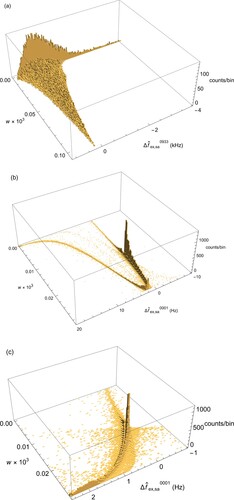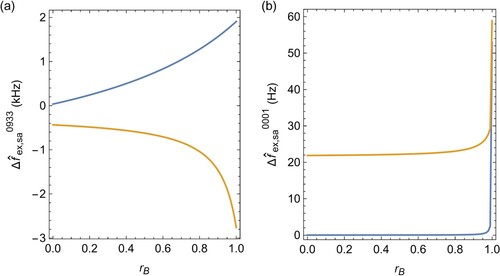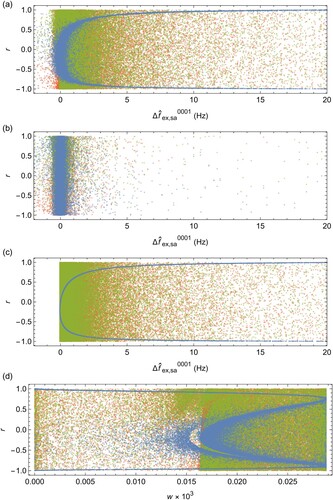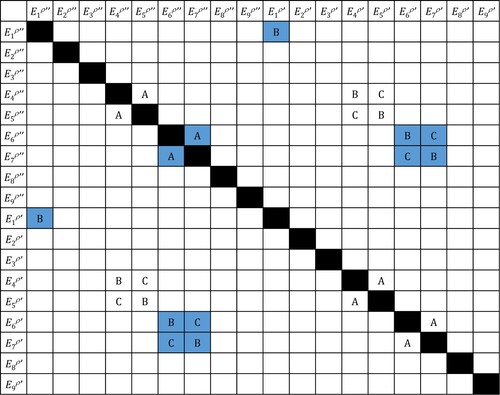Figures & data

Figure 1. Adjustment of and
for various correlation scenarios [labelled by the tuples
]. The corresponding theoretical predictions
are those from Refs. [Citation11,Citation12] and are indicated by the vertical dashed lines, while the shaded area represents the corresponding theoretical uncertainty
. For completeness, a more recent value of
by Korobov and Karr [Citation7] is shown as a separate data point. (a) Results for the
:
transition, considering correlations only for
and
. The value of
as determined by Patra et al. [Citation11] is also indicated. (b) Same as (a), but for the
:
transition using the data of Alighanbari et al. [Citation12]. (c) Same as (a), but now considering
(type-B correlation only), and the pairs
and
. (d) Same as (b), but now including also type-A correlations between
.
![Figure 1. Adjustment of fex,sa0933 and fex,sa0001 for various correlation scenarios [labelled by the tuples (rA,rB,rC)]. The corresponding theoretical predictions fth,sa are those from Refs. [Citation11,Citation12] and are indicated by the vertical dashed lines, while the shaded area represents the corresponding theoretical uncertainty u(fth,sa). For completeness, a more recent value of fth,sa by Korobov and Karr [Citation7] is shown as a separate data point. (a) Results for the (v,N): (0,3)→(9,3) transition, considering correlations only for E4ρ and E5ρ. The value of fex,sa0933 as determined by Patra et al. [Citation11] is also indicated. (b) Same as (a), but for the (v,N): (0,0)→(0,1) transition using the data of Alighanbari et al. [Citation12]. (c) Same as (a), but now considering E1ρ (type-B correlation only), and the pairs E4ρ,E5ρ and E6ρ,E7ρ. (d) Same as (b), but now including also type-A correlations between E6ρ,E7ρ.](/cms/asset/894c29f0-8b6f-4996-901a-4832d1809427/tmph_a_2058637_f0001_oc.jpg)
Figure 2. Results of Monte-Carlo runs. (a) :
transition, 49,701 realisations. (b)
:
transition, 49,550 realisations. (c) Zoomed-in portion of the histogram shown in (b).

Figure 3. Weight (or probability) w versus r for the Monte-Carlo run shown in Figure (a). Although not visible from the graph, the different coloured dots occur in vertically aligned groups of three, each group corresponding to a single adjustment with correlation coefficients (blue),
(green), and
(red) (colour online only).

Figure 4. Dependence of the adjusted frequency on the correlation coefficient . (a)
versus
for the scenario
, and considering correlations between
and
(upper curve), and between
,
,
,
, and
(lower curve). For the upper and lower curves, the limiting cases
and
are also shown in Figure (a) and Figure (c), respectively. A uniform expansion factor
was applied. (b)
versus
for the scenario
, and considering correlations between
and
(lower curve), and between
,
,
, and
(upper curve). In this case, for the lower and upper curves, the limiting cases
and
are also shown in Figure (b) and Figure (d), respectively.

Figure 5. Shift of versus values of
(blue),
(green), and
(red), obtained from Monte-Carlo runs (colour online only). Although not visible from the graphs, the different coloured dots occur in vertically aligned groups of three, each group corresponding to a single adjustment with correlation coefficients
. (a) Results of a ∼50,000-point Monte-Carlo run involving
,
,
, and
. (b) Same as in (a), but now involving only
and
. (c) Same as (a), but now involving only
and
. (d) Weight (or probability) w versus r for the run involving
,
,
, and
. This run was also used to produce Figure (b).

Table 1. Correlation-induced shift and standard uncertainty, as obtained from unweighted and weighted results of the Monte-Carlo runs, to the :
and
:
spin-averaged transition frequencies.
Table 2. Correlation-induced shift and standard uncertainty (in ppt), to the value of , as obtained from unweighted and weighted results of the Monte-Carlo runs.
Figure A1. Graphical overview of correlation coefficients. Empty cells correspond to correlation coefficients which are always set to zero, either because the corresponding covariances are negligibly small on an absolute frequency scale, or because the spin coefficients involved are unlikely to be uncorrelated as they represent physically distinct interactions. Nonzero correlations of type A, B and C are indicated. Cells with a shaded background correspond to correlations that are nonzero only in the :
analysis.

